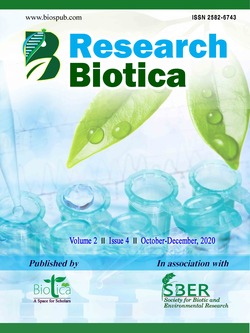
Declining Nutrients from Our Plates
Anjali Tiwari
G.B. Pant National Institute of Himalayan Environment (GBP-NIHE), Kosi-Katarmal, Almora, Uttarakhand (263 643), India
Kapil Kesarwani*
G.B. Pant National Institute of Himalayan Environment (GBP-NIHE), Kosi-Katarmal, Almora, Uttarakhand (263 643), India
Tapan Ghosh
G.B. Pant National Institute of Himalayan Environment (GBP-NIHE), Kosi-Katarmal, Almora, Uttarakhand (263 643), India
Sumit Rai*
G.B. Pant National Institute of Himalayan Environment (GBP-NIHE), Kosi-Katarmal, Almora, Uttarakhand (263 643), India
DOI: https://doi.org/10.54083/ResBio/2.4.2020.135-140
Keywords: Climate change, Food security, Human health, Malnutrition, Nutrition
Abstract
Change in climate directly effects on the agricultural ecosystem that results in changing agricultural climatic elements such as temperature, precipitation and sunlight. The impacts of climate change on global food system, nutrition and health will depend on a variety of environmental factors. Due to continuously increasing global temperature, the negative impact of climate change on agricultural crops includes reduction in crop quality and quantity. The increasing population demands more food which resulted intensive agricultural practices like the use of pesticides, livestock generation, extensive use of water resources. The high anthropogenic activities result, degradation of natural resources. Now, it is the need of the hour to strengthen our capacities to combat these constant environmental changes with integration of knowledge from, ancestors, communities and scientific innovations. Technological innovations to meet the local needs of food and nutrition with best practices for producing, preserving and preparing healthy foods.
Downloads
not found
Reference
Attina, T.M., Hauser, R., Sathyanarayana, S., Hunt, P.A., Bourguignon, J.P., Myers, J.P., DiGangi, J., Zoeller, R.T., Trasande, L., 2016. Exposure to endocrine-disrupting chemicals in the USA: A population-based disease burden and cost analysis. The Lancet Diabetes & Endocrinology 4(12), 996-1003.
Blain, P.G., 2011. Organophosphorus poisoning (acute). BMJ Clinical Evidence 2011, 2102.
Davis, D.R., Epp, M.D., Riordan H.D., 2004. Changes in USDA food composition data for 43 garden crops, 1950 to 1999. Journal of the American College of Nutrition 23, 669-682.
Ekholm, P., Reinivuo, H., Mattila, P., Pakkala, H., Koponen, J., Happonen, A., Hellström, J., Ovaskainen, M.L., 2007. Changes in the mineral and trace element contents of cereals, fruits and vegetables in Finland. Journal of Food Composition and Analysis 20(6), 487-495.
Fantke, P., Friedrich, R., Jolliet, O., 2012. Health impact and damage cost assessment of pesticides in Europe. Environment International 15(49), 9-17.
FAO, IFAD, UNICEF, WFP, WHO, 2018. The State of Food Security and Nutrition in the World 2018. Building climate resilience for food security and nutrition. Rome, FAO.
FNSAI, 2019. Food and Nutrition Security Analysis, India. Ministry of Statistics and Programme Implementation & the World Food Programme. p. 254.
Gopalan, C., Rama Sastri, B.V., Balasubramanian, S.C., 2004. Nutritive value of Indian foods. Printed by National Institute of Nutrition, Indian Council of Medical Research, Hyderabad-500 007, India. p. 58.
IPCC, 2007. Climate Change 2007: Impacts, Adaptation and Vulnerability. Contribution of Working Group II to the Fourth Assessment Report of the Intergovernmental Panel on Climate Change. (Eds.) Parry, M.L. Canziani, O.F. Palutikof, J.P. van der Linden, P.J. and Hanson, C.E. Cambridge University Press, Cambridge, UK. p. 976.
Kanwal, M.S., Mukherjee, S., Joshi. R., Rai, S., 2019. Impact assessment of changing environmental and socio-economical factors on crop yields of central Himalaya with emphasis to climate change. Environment and Ecology 37(1B), 324-332.
Kumar, S., Kumar, A., Rai, S., Suryakant., Singh, R., 2015. Influence of mulching and NPK levels on growth, yield and economics of pearl millet in Bael based agri-horticultural system under rainfed Vindhyan Region. Nature Environment and Pollution Technology 14(3), 627-632.
Longvah, T., Ananthan, R., Bhaskarachary, K., Venkaiah, K., 2017. Indian Food Composition Tables. Printed by National Institute of Nutrition, Indian Council of Medical Research, Hyderabad-500 007, India. p. 578.
Mayer, A.M.B., 1997. Historical changes in the mineral content of fruits and vegetables. British Food Journal 99(6), 207-211.
Rai, A.K, Rakshit, A., Rai, S., Parihar, M., Seth, V., 2016. Factors responsible for phosphorus uptake efficiencies of crop species in hot sub humid eco-region of middle Gangetic Plains of India. Journal of Pure and Applied Microbiology 10(2), 1303-1310.
Rai, S., Rani, P., Kumar, M., Rai, A.K., Shahi, S.K., 2014. Effect of integrated use of vermicompost, FYM, PSB and azotobactor on physicochemical properties of soil under onion crop. Environment & Ecology 32, 1797-1803.
Rani, P., Singh, A.P., Rai, S., 2015. Effect of rice husk biochar and lime treated sludge on NPK concentration and uptake by rice crop. Environment and Ecology 33(3A), 1218-1224.
Singh, A.P., Singh, S.K., Rai, S., Kumar, M., 2020. Soil carbon dynamics in relation to soil surface management and cropping system. In: Carbon Management in Tropical and Sub-Tropical Terrestrial Systems. (Eds.) Ghosh, P.K., Mahanta, S.K., Mandal, D., Mandal, B. and Ramakrishnan, S. Springer, Singapore. pp. 159-172.
